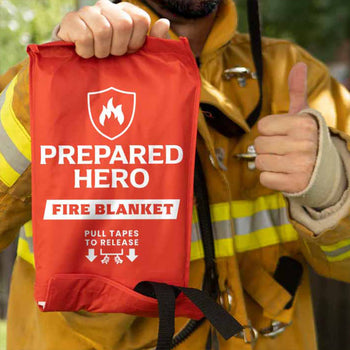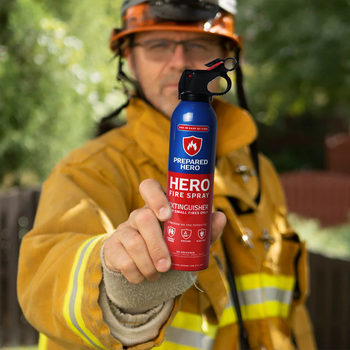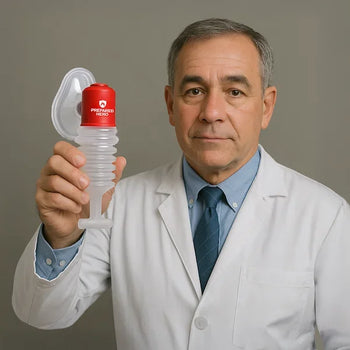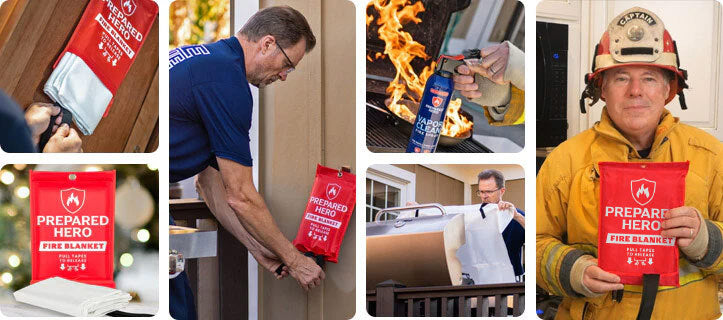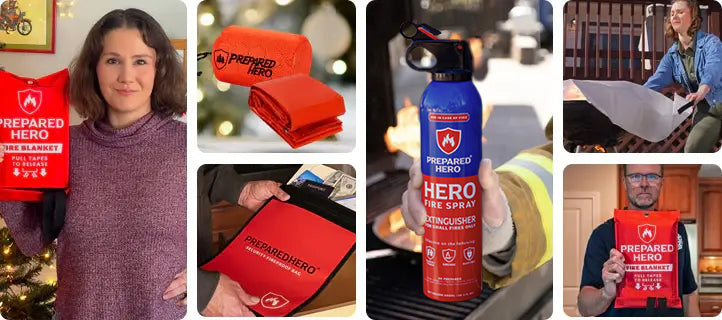Where you put your smoke detectors matters just as much as installing them. Proper placement makes sure they can detect...
Fire pits are great for hanging out, roasting marshmallows, or staying warm during cold nights. But before you light yours up, you should know if a fire pit is considered open burning.
You see, there are rules about when and where you can use a fire pit, what you’re allowed to burn, and how to put out the fire safely. Whether you’re new to fire pits or need a refresher, this guide will help you stay safe and prevent fire risks.
What Is Open Burning?

As the term suggests, open burning means setting fire to things outside. It includes burning things in a fire pit, barrel, or a pile on the ground. Unlike closed burning, the smoke goes straight into the open without a filter or chimney.
Open burning is common because people burn things like wood scraps, leaves, and other yard waste outside. However, you can get into trouble for burning things like household trash in many states. Some places allow it under certain conditions, but most don’t. It’s because smoke inhalation is harmful, and irresponsible open burning is a fire risk. So, always check local laws before you burn anything in the open.
Are Fire Pits Considered Open Burning?
Yes, a fire pit can be counted as open burning if you burn wood, paper, leaves, or other materials in an open or semi-enclosed space without a proper combustion system or fire safety features. Since many fire pits are designed for the outdoors and don’t have combustion systems, lighting them up is usually considered open burning.
In addition, using fire pits usually calls for a permit or is subject to regulations depending on the type you’re using and local laws. For instance, wood-burning fire pits, especially those on the ground, are classified as open burning.
However, some states or cities may exclude certain fire pits (like covered ones or those off the ground) from open burning regulations, especially if they’re used for recreational purposes like warmth or minor cooking.
What Is Not an Open Fire?

Contrary to popular belief, not all outdoor fires count as open fires. For instance, using a gas stove, electric grill, or fire pits for cooking isn’t classified as open burning.
Open burning means burning materials like wood, leaves, or trash in an open flame without a controlled combustion system. Since they’re not meant for waste disposal and don't release large amounts of smoke or pollutants into the air, they’re not counted as open fires. Plus, outdoor furnaces or boilers used to heat buildings aren’t considered open fires either if used properly.
The thing is, the fire needs to be contained and controlled. So, if the fire is inside a device made for heating or cooking, it usually doesn’t count as open burning.
What Can You Burn in an Open Fire?
You can’t burn anything you want in an open fire. Recreational fires are meant for warmth, cooking food, or a cozy vibe, not burning trash.
Want an open fire? Make sure the materials you use are safe. These include clean and dry firewood or charcoal. Burning leaves, trash, or paper is bad for the environment and often against local rules. You see, paper and cardboard can produce a lot of smoke and may contain chemicals that aren't safe to breathe. While you can burn these materials in an open fire, you’re at risk of being burned or penalized.
In addition, treated wood pallets are off-limits because they release toxic gases. Green branches might look safe, but they don’t burn well and give too much smoke because of the moisture in them. Tires, roofing materials, and the like shouldn’t be burned in an open fire, either.
Where you burn your fire matters as well. According to the experts, fire pits or rings must be at least 10 feet away from structures and combustible materials. These include houses, sheds, attached garages, and vehicles. So, make sure to maintain your distance when lighting up a bonfire or fire pit. You’ll enjoy the fire more if it’s legal and safe.
Is a Fire Pit Considered an Outdoor Fireplace?

A fire pit isn’t exactly an outdoor fireplace. Both are used outside to make people feel warm and cozy, but they have different features.
For one, a fire pit is typically an open bowl or hole in the ground where you can start a fire. People can also sit around it, which makes it ideal for casual hangouts on cold nights. On the other hand, an outdoor fireplace looks more like the one you see indoors. It is bigger, leans on a wall, and has a chimney. While they have the same purpose, a fire pit is not the same as an outdoor fireplace.
Local Regulations and Permits
Many states and cities require permits before you can build or use a fire pit. Check your local rules and regulations because what’s allowed in one area might be banned in another. For instance, many states allow small recreational fires as long as you follow some basic rules.
For instance, your fire pit should be 10 to 25 feet away from anything that could catch fire. These include houses, sheds, bushes, fences, and trees. Most states also limit the size to three feet in diameter and two feet in height. They also only allow their use for cooking, warmth, or relaxing outdoors.
Plus, they can’t be used at all if there's a burn ban. Burn bans are usually implemented during red flag warnings, wildfire season, or extremely windy weather. These bans apply to all fires, including the small ones. For this reason, you have to stay updated and check the news before using your fire pit.
You might also need a permit depending on where you live, especially if you’re burning wood. Some places require permits for big open fires, while others require permits for any type or size.
The best way to stay safe and legal? Check your local fire pit rules or give your fire department a quick call. It only takes a minute and saves you from possible fines and fire hazards.
How to Use Your Fire Pit Safely

You should know the basics before lighting up your fire pit. Here are some tips to stay safe, follow the rules, and enjoy your fire without any problems:
1. Check the rules.
Know your local fire regulations before lighting anything. Some areas have burn bans or permit requirements, especially during dry seasons.
2. Use the right setup.
Use fire pits that are made for outdoor fires and follow the manufacturer’s instructions. Avoid DIY setups that aren’t built to handle high heat.
3. Keep an eye on it.
Never leave the fire alone, even for a minute. Fires can spread fast if left unattended, especially if it’s windy outside.
4. Stay prepared.
Have a fire blanket, fire spray, or fire extinguisher nearby. Having fire safety tools close by lets you put out fires quickly and prevent them from causing more damage.
Unlike bulky extinguishers, fire sprays and blankets are lightweight and easy enough for anyone to use, even in a hurry. Just spray or cover and go.
6. Pick a safe spot.
Set your fire pit at least 10 feet away from your home, fences, trees, or anything flammable. A flat, open area also keeps things under control.
7. Burn the right stuff.
Only use dry, seasoned firewood. Never use trash, treated wood, or leaves because they can release toxic smoke or cause flare-ups.
8. Keep things clear.
Make sure chairs, blankets, and food are far enough from the fire. Sparks can fly farther than you think, especially on breezy nights.
9. Don’t use lighter fluid.
Don’t use gasoline or lighter fluid because they can start uncontrollable fires. A fire starter stick or kindling is a safer and more controlled option.
10. Put it out completely.
Pour water over the fire and stir the ashes when you’re done. Keep adding water and stirring until everything is cool to the touch. You can use a fire spray or extinguisher as an alternative.
When Should You Not Use a Fire Pit?

There are times when it’s not safe to use a fire pit. For example, avoid using one under a covered patio or any enclosed space because it can trap smoke and increase fire risk. Don’t light a fire during high winds, near flammable items, or under low-hanging trees as well.
Plus, fire pits are a no-go during burn bans. Never burn things like treated wood, garbage, or plastic because they produce harmful fumes. Always pick an open, clear spot and keep a close eye on the fire. Being careful about when and where you use your fire pit keeps things safe and helps you avoid trouble.
Do You Put the Lid on a Fire Pit While Burning?
Don’t put the lid on your fire pit while it’s burning. Doing this can block airflow, trap heat, and damage your fire pit. Fire needs air to burn safely, so it’s best to leave the lid off while the flames are going. Then, wait until the fire is completely out and everything has cooled down before putting the lid back on.
Can I Leave My Fire Pit Burning Overnight?

No, you should never leave a fire pit burning overnight. It’s not safe and is against the law. Even small embers can reignite and start a fire when you’re not around to stop it. So, make sure the fire is completely out before heading to bed or leaving the area. Use a fire spray, fire extinguisher, fire snuffing lid, water, or sand to kill all the embers. It takes a few minutes and can prevent serious accidents.
Conclusion
Fire pits are fun, but they come with rules and risks you shouldn’t ignore. Whether you're using one for warmth, cooking, or relaxing, you should know if it counts as open burning in your area. Follow local regulations and burn safe materials. With the right setup and care, you can enjoy your fire pit without putting yourself or anyone else in danger.
Do you want reliable, easy-to-use, and affordable tools to put out fires before they spread? Check out Prepared Hero’s fire prevention tools here, and get up to 51% off on certain items. Stay prepared, hero!


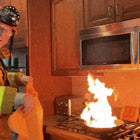 Fire
Fire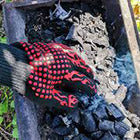 Safety
Safety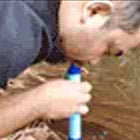 Survival
Survival Protection
Protection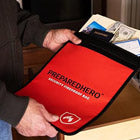 New
New Scouting America
Scouting America
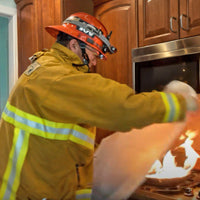 Fire
Fire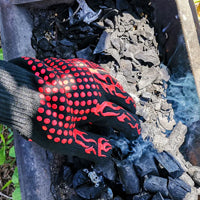 Safety
Safety Survival
Survival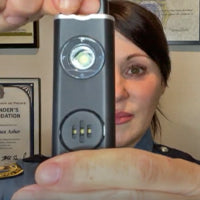 Protection
Protection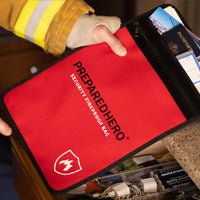 New
New
